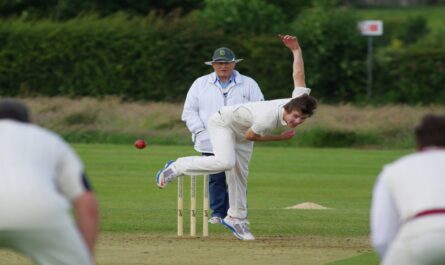A cricket bat is an essential tool in the game of cricket whose size, shape and weight has evolved over the period of time. Dimensions of cricket bat are discussed in detail under the LAW 5 of MCC rules where a bat has to meet certain criterias before being use in international cricket. A bat mainly consists of two parts mainly, a handle and a blade. Further detailed dimensions of cricket bat are given below:
Dimensions of Cricket Bat
The Handle
The part of the blade that is completely outside of the cricket bat’s blade is known as the upper part of the handle, which is a straight shaft for holding the bat. The outer portion of the bat can be covered with a grip. The handle can be made up of cane or wood.
The Blade
The blade comprises of the bat apart from the handle which is completely made up of wood. Bats may have commercial identifications on the blade, the size of which must comply with the specifications given in rule book.
Protection and Repair
Protection and repair of the bat can only be carried out for the sole purpose of either protection from surface damage to the face,sides and shoulder of the blades or repair to the surface of the blade after damage. Material used for these purposes should not be rigid. Solid material can be inserted after damage to the surface which must be wood with minimum essential adhesives. Likewise, material can be added to the toe of the bat to prevent damage which shall not extend the authorize limit as given by ICC regarding dimensions of cricket bat.
Damage to the Ball
The material used in a bat should not cause damage to the ball. Any material used on the surface should not be such that it damages the ball than the normal wear and tear which is caused by the ball striking the uncovered wooden surface of the blade. This is one of the reason that MCC has given detailed dimensions of cricket bat.
Also Read : The Cricket Ball
Contact with the Ball
There are specific conditions which should be met before one can say that the bat is in contact with the ball. Contact between the ball, the bat itself, the batter’s hand holding the bat, any part of the glove worn on the batter’s hand holding the bat, shall be regarded as the ball striking or touching the bat or being struck of the bat.
Dimensions of Cricket Bat size limits
Cricket bats which are used in cricket have to match the dimensions as laid out by the MCC. The overall length of the bat once the lower portion is inserted, shall not be more than 38 in/ 96.52 cm. For bats of size 6 and less, the handle shall not exceed 52% of the overall length of the bat. As for as the remaining dimensions of the blade are concerned, it should not exceed the following dimensions:
- Width : 4.25 in/ 10.8 cm
- Depth : 64 in/ 6.7 cm
- Edges : 56 in/ 4.0 cm
A bat should also be able to pass through a bat gauge in order to be permitted to be used by the batters. Material permitted for covering the blade of the bat should not exceed 0.04 in/ 0.1 cm in thickness while covering the toe of the bat, the thickness should not exceed 0.12 in/ 0.3 cm.
Also Read : Dimensions of a Cricket Pitch, Crease and Stumps
Categories of Cricket Bat
Dimensions of cricket bat vary in different forms of the game. There are 4 categories of bats which includes Type A, B, C and D which are used in international cricket. Apart from these categories, no other bat is recognized in the law which does not meet the dimensions of bat as discussed. Type A, B and C are bats which comes under the dimensions mentioned above whereas Type D bats are used in junior cricket only.
- Type A bats may be used at any level of cricket.
- Type B, C, D and any other bats may be at or below levels determined by the governing body for cricket in the country concerned.
- Type D bats may be used in junior cricket only.
Conclusion
ICC has provided a detailed guideline to cricketers on use of a cricket bat. Every batsman prefers their own choice of bat as per their comfort. But every bat used in international cricket must fulfill the criteria of dimensions of cricket bat as laid down by ICC. Some of the famous brands of bats include Gray-Nicolls, English Willow etc.
Visit Our YouTube Channel : Cricket Maverick
FAQs
1. What are the two main parts of a cricket bat?
– Answer: A cricket bat consists of two main parts: the handle and the blade.
2. What are the size limits for a cricket bat according to MCC Rules?
– Answer: According to MCC Rules, the overall length of the bat, once the lower portion is inserted, should not exceed 38 inches (96.52 cm). For bats of size 6 and less, the handle should not exceed 52% of the overall length. Additionally, there are limits for width, depth, and edges of the blade.
3. Are there different categories of cricket bats used in international cricket, and what are their distinctions?
– Answer: Yes, there are four categories of cricket bats: Type A, B, C, and D. Type A bats can be used at any level of cricket, while Type B, C, and D bats may be used at or below levels determined by the governing body for cricket in the respective country. Type D bats are specifically for junior cricket.
4. When is it permissible to protect or repair a cricket bat, and what materials can be used for this purpose?
– Answer: Protection and repair of a bat are allowed for the sole purpose of safeguarding against surface damage or repairing the surface after damage. The material used should not be rigid, and solid material can be inserted after damage to the surface, which must be wood with minimum essential adhesives.
5. Why are specific dimensions and regulations for cricket bats necessary, according to MCC and ICC?
– Answer: Specific dimensions and regulations for cricket bats are necessary to maintain fairness, safety, and consistency in the game. They ensure that bats conform to standard sizes and materials, preventing potential advantages or disadvantages for players and maintaining the integrity of the sport.



